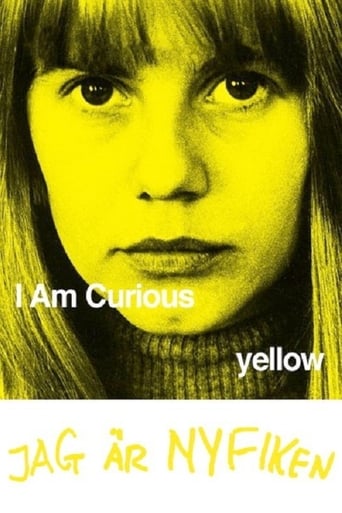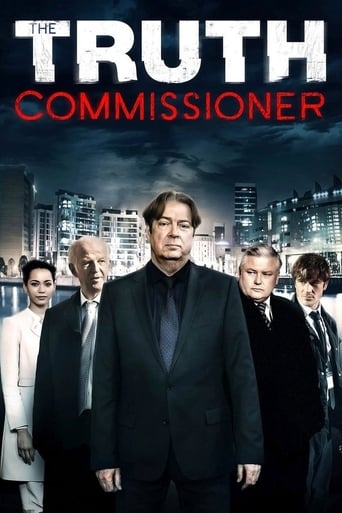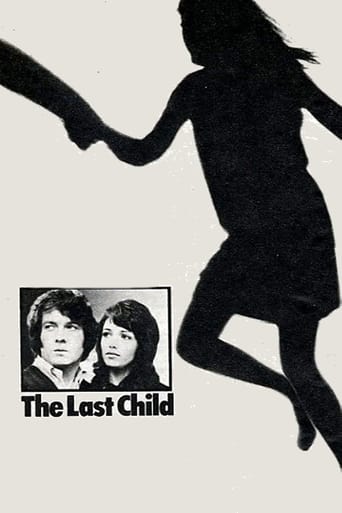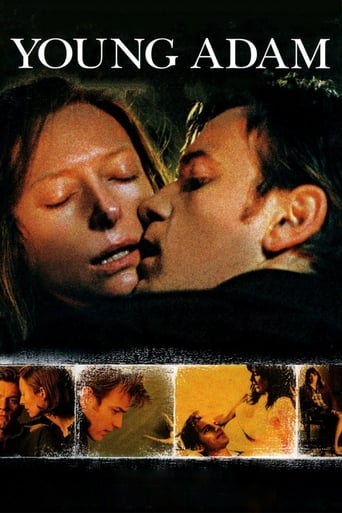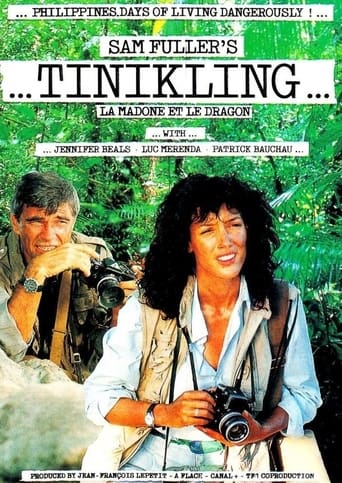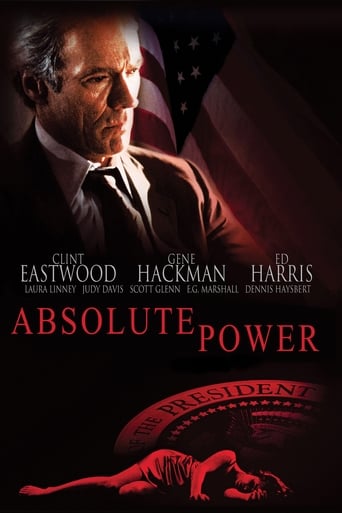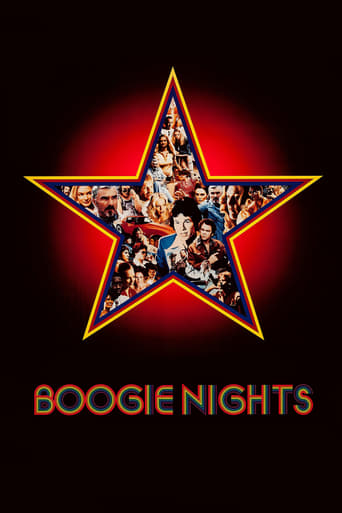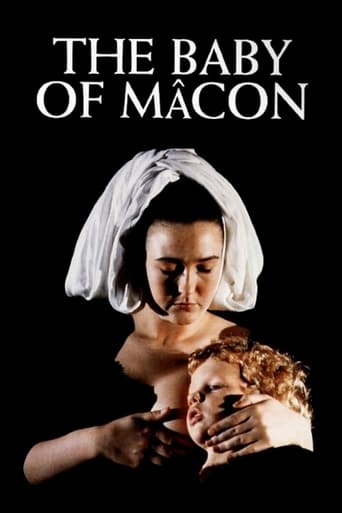I Am Curious (Yellow) (1967)
Lena, aged twenty, wants to know all she can about life and reality. She collects information on everyone and everything, storing her findings in an enormous archive. She experiments with relationships, political activism, and meditation. Meanwhile, the actors, director and crew are shown in a humorous parallel plot about the making of the film and their reactions to the story and each other. Nudity, explicit sex, and controversial politics kept this film from being shown in the US while its seizure by Customs was appealed.
Watch Trailer
Free Trial Channels
Cast


Similar titles
Reviews
Lack of good storyline.
The performances transcend the film's tropes, grounding it in characters that feel more complete than this subgenre often produces.
In truth, there is barely enough story here to make a film.
It’s not bad or unwatchable but despite the amplitude of the spectacle, the end result is underwhelming.
The film I am curious - yellow is made in the style of the nouvelle vague. Apparently this style was invented by the French director Jean-Luc Godard (Tout va bien, La Chinoise, Weekend). In my view the hallmark of such films is an incoherent story, with surreal incidents, and a lack of emotions. People are ruined but do not seem to notice it. This type of films was made mainly in the roaring sixties and early seventies, by innovative producers. So it is no surprise that I am curious - yellow starts as a political film. This part is almost a documentary. It describes the then Swedish society, which was very egalitarian. The socialist prime minister Olaf Palme appears in a minor role. The main character is Lena, a rather simple young woman. She wants to know if Sweden is a class society, and asks everybody. She adores Martin Luther King. The Swedish television shows how the army decides to employ non-violent resistance against the Red Army! The right to bear arms is slightly less ludicrous than the right to arm bears. Halfway the film the story becomes more personal. Lena engages in sexual experiments, hoping to develop her sexual identity. Time and again she has disappointing experiences. "To err is human", said the hedgehog, and jumped from the cactus. Or, he: "Would you like to join me for a pancake?" She: "OK, but no crumbs in bed". Finally she gets so enraged, that she abjures the ideal of King. In fact she abandons her social engagement, and destroys her archives with press cuttings. Apparently most personalities can not bear the self- sacrifice in collective action, which probably is the message of producer Sjöman. In a world without men there would be no war, just intense negotiations every 28 days. All in all the shocking naivety of the Swedish people got stuck in my mind. In addition some of the surreal moments and scenes are quite funny and surprising. This makes the film worth watching. Don't hesitate to leave a comment. I love it.
This is a landmark Swedish film, that pretty much changed the way American films at least, looked at censorship, especially nudity and sex in general. Banned at first in American in 1969, the ruling was overturned and it made a huge amount of money. I believe this is the first time I have watched the entire 2 hour movie, and found it very interesting indeed on a couple of levels. First of all, many people will probably find it a bit boring, but there is much to like. To me, the controversial material is not the frontal male and female nudity and sex scenes, but the political message, which I interpret as nothing but Communism. There's not really a plot, it's about a girl hooked on her very very left wing activist politics, and her uninhibited sex life. I would call the political theme radical, but remembering how things were back then, the censors were more concerned about the male frontal nudity, and one particular scene where she kisses a guys flaccid penis. Big deal, we have indeed come a long long way. The movie is important, because it opened up the American film market to just about everything, and you could say, helped launch the mainstream porn market because they benefited greatly by the relaxed censorship laws. Today, the movie is not shocking in the least, but still an interesting and historical exposition and the changes occurring in the sixties. I have the companion film "I Am Curious (Blue)" on loan from the library too, which with (Yellow) was supposed to be one long film, but they broke it up into two. The Yellow and Blue comes from the Swedish flag. Did you hear me, I got them from the library. That's saying a lot about how much things have changed.
The films are based upon the two colors of the Swedish flag- a scheme that a quarter century later Polish filmmaker Krzysztof Kieslowski would use to far greater effect with his Three Colors trilogy based upon the colors of the French flag. Neither of Sjöman's films are a good film, although Blue is better, for it has a bit better character arc, is less self-conscious, more meditative, and is fourteen minutes shorter (107 vs. 121), but neither are outright horrible films- merely dull and, with time's leveling, pointless exercises in puerile political masturbation. Blue does reuse some scenes from Yellow- such as scenes at a car dealership and a sex clinic. The films just seem sort of pointless all these years later. In retail language, they had a very short shelf life. Artistically, they are Ingmar Bergman on a really bad day, although Bergman was Sjöman's filmic idol, and politically they are about as deep as a thimble, larded with the naïve Left Wing tripe that the 1960s overdosed on, in reaction to the dying Right Wing Colonialist culture that arose for a last time after the Second World War. That Sjöman was 42 years old when he made these lightweight films is the only thing surprising because their ranting is more in line with a teenager's to their parent, when they are not allowed to do something destructive.The two films follow the same tale, from slightly different perspectives. The putative lead character in both, Lena (Anna Lena Lisabet Nyman), is a 22 year old drama student sleeping with the 42 year old filmmaker Sjöman. The film is semi-documentary, and yet the camera also goes behind the scenes of the making of the film within the film, as well as ostensibly following Lena and other characters, like her on screen and offscreen lover Börje (Börje Ahlstedt) in places where it could not go, but the viewer is asked to believe unquestioningly. Of course, this mushes up the real, the 'real', and the staged, but not in a good nor profound way, and since none of the characters are deep nor well drawn, a viewer really has no interest in sniffing out which level is which, assuming that the levels confuse any viewers of intelligence .Like Bernardo Bertolucci's lame Last Tango In Paris, a few years later, neither of the I Am Curious films have relevance for anyone outside of their generation, which is a surefire marker that the art is bad. The acting is uniformly atrocious- Nyman later had a small role in Ingmar Bergman's 1978 Autumn Sonata, as the spastic daughter, but then faded from film history. Her co-stars were even less successful, and the I Am Curious films deserved their oblivion, for the years' passage has seen what at least seemed bold and innovative get pared down to dull and pretentious. Both films end abruptly, with no power nor insight, and if done to give verisimilitude to their 'reality', it seems a waste, for no one really can buy into what either film is selling- just as their self-conscious TV-style hucksterism seems aimed at children, not adults.Vilgot Sjöman may have made some good or even great films before or after these, but these are a waste of most viewers' time, and do not even hold the historical power that the Up films from Britain do, for those films are real documentaries, while these are mere fantasies of a Utopia that never was, and could never be- as evidence by Lena's simpleminded anti-education raps. Thus leveled, time seeks a new Ozymandias.
This film, once sensational for its forward-thinking politics and depictions of free love and sexual liberation, has been reduced by time to a mere curiosity. It seems absurd now that this mostly boring little film had been banned and seized by governments in many countries. Given how socialistic Sweden eventually became, the 'radicalism' of its politics, once controversial, appear naive and almost mainstream four decades later. And its sex scenes, at one time the subject of sensational obscenity trials, look pretty tame in a modern context. Nevertheless, the film and accompanying documentaries detailing its many controversies and influences remains marginally watchable as an early reliquary of 60's youth rebellion. One part of the film that still holds up: its self-consciousness with respect to the 'fourth wall'. Every once in a while, the filmmakers film themselves making the film. The satiric playfulness of this still elicits a chuckle.

